The Impact of the Electric Double-Layer Capacitor (EDLC) in Reducing Stress and Improving Battery Lifespan in a Hybrid Energy Storage System (HESS) System
Abstract
1. Introduction
2. Methodology
2.1. Modelling and Parameter Extraction from the Live EDLC to Develop the PMS-Hybrid Simulation Model of the EDLC
2.2. Design of the Experimental HESS Model and the MATLAB/Simulink Simulation HESS Model with a PMS-Hybrid EDLC as a Sub-Component
3. Results and Analysis
3.1. Results for the EDLC
3.2. Results for Experimental HESS and Simulated HESS Relating to Battery Life
3.2.1. Experimental HESS Results
3.2.2. Simulated HESS Results
3.2.3. Variable Load/Current Results for the Experimental HESS Only
4. Discussions
5. Conclusions
Author Contributions
Funding
Institutional Review Board Statement
Informed Consent Statement
Data Availability Statement
Acknowledgments
Conflicts of Interest
References
- Danila, E. History of the first energy storage systems. In Proceedings of the 3rd International Symposium on the History of Electrical Engineering and of Tertiary Level Engineering Education, Iasi, Romania, 27–29 October 2010. [Google Scholar]
- Prasad, G.G.; Shetty, N.; Thakur, S.; Bommegowda, K.B. Supercapacitor technology and its applications: A review. IOP Conf. Ser. Mater. Sci. Eng. 2019, 561, 012105. [Google Scholar] [CrossRef]
- Sayed, K.; Kassem, A.M.; Aboelhassan, I.; Aly, A.M.; Abo-Khalil, A.G. Role of supercapacitor energy storage in DC microgrid. Menoufia J. Electron. Eng. Res. 2019, 28, 263–268. [Google Scholar] [CrossRef]
- Camara, M.A. Modeling of a hybrid energy storage system supplied by a photovoltaic source to feed a DC motor. Int. J. Renew. Sustain. Energy 2013, 2, 222–228. [Google Scholar] [CrossRef]
- Jing, W.; Lai, C.H.; Wong, S.H.W.; Wong, M.L.D. Battery-supercapacitor hybrid energy storage system in standalone DC microgrids: A review. IET Renew. Power Gener. 2017, 11, 461–469. [Google Scholar] [CrossRef]
- Saha, R.; Dey, J.P.V. Battery and ultra-capacitor based hybrid energy storage system. In Proceedings of the IEEE 16th India Council International Conference (INDICON), Rajkot, India, 13–15 December 2019; pp. 1–4. [Google Scholar]
- Tshiani, C.T.; Umenne, P. The characterization of the Electric Double-Layer Capacitor (EDLC) using Python/MATLAB/Simulink (PMS)-hybrid model. Energies 2022, 15, 5193. [Google Scholar] [CrossRef]
- Argyrou, M.C.; Christodoulides, P.; Marouchos, C.C.; Kalogirou, S.A. Hybrid battery-supercapacitor mathematical modeling for PV application using Matlab/Simulink. In Proceedings of the 53rd International Universities Power Engineering Conference (UPEC), Glasgow, UK, 4–7 September 2018; pp. 1–6. [Google Scholar]
- Sahin, M.E.; Blaabjerg, F. A hybrid PV-battery/supercapacitor system and a basic active power control proposal in MATLAB/Simulink. Electronics 2020, 9, 129. [Google Scholar] [CrossRef]
- Sahin, M.E.; Blaabjerg, F.; Sangwongwanich, A. Modelling of supercapacitors based on simplified equivalent circuit. CPSS Trans. Power Electron. Appl. 2021, 6, 31–39. [Google Scholar] [CrossRef]
- Li, J.; Xiong, R.; Mu, H.; Cornélusse, B.; Vanderbemden, P.; Ernst, D.; Yuan, W. Design and real-time test of a hybrid energy storage system in the microgrid with the benefit of improving the battery lifetime. Appl. Energy 2018, 218, 470–478. [Google Scholar] [CrossRef]
- Gee, A.M.; Dunn, R.W. Novel battery/supercapacitor hybrid energy storage control strategy for battery life extension in isolated wind energy conversion systems. In Proceedings of the 45th International Universities Power Engineering Conference (UPEC2010), Cardiff, UK, 31 August–3 September 2010; pp. 1–6. [Google Scholar]
- Bahloul, M.; Khadem, S.K. Impact of power sharing method on battery life extension in HESS for grid ancillary services. IEEE Trans. Energy Convers. 2018, 34, 1317–1327. [Google Scholar] [CrossRef]
- Hajiaghasi, S.; Salemnia, A.; Hamzeh, M. Hybrid energy storage system for microgrids applications: A review. J. Energy Storage 2018, 21, 543–570. [Google Scholar] [CrossRef]
- Oussama, H.; Othmane, A.; Amine, S.M.; Amine, H.M.; Abdeselem, C.; Abdelkader, A.B. Modeling and control a DC-microgrid based on PV and HESS Hybrid Energy Storage System. Presented at the First International Conference on Smart Grids, CIREI’, Oran, Algeria, 4–6 March 2019; pp. 1–5. [Google Scholar]
- Li, F.; Xie, K.; Yang, J. Optimization and analysis of a hybrid energy storage system in a small-scale standalone microgrid for Remote Area Power Supply (RAPS). Energies 2015, 8, 4802–4826. [Google Scholar] [CrossRef]
- Suzuki, S.; Baba, J.; Shutoh, K.; Masada, E. Effective application of Superconducting Magnetic Energy Storage (SMES) to load leveling for high speed transportation system. IEEE Trans. Appl. Supercond. 2004, 14, 713–716. [Google Scholar] [CrossRef]
- Faranda, R.; Gallina, M.; Son, D.T. A new simplified model of Double-Layer Capacitors. In Proceedings of the International Conference on Clean Electrical Power, Capri, Italy, 21–23 May 2007; pp. 706–710. [Google Scholar]
- Papic, I. Simulation model for discharging a lead-acid battery energy storage system for load leveling. IEEE Trans. Energy Convers. 2006, 21, 608–615. [Google Scholar] [CrossRef]
- Bai, Y.; Li, J.; He, H.; Dos Santos, R.C.; Yang, Q. Optimal design of a hybrid energy storage system in a plug-in hybrid electric vehicle for battery lifetime improvement. IEEE Access 2020, 8, 142148–142158. [Google Scholar] [CrossRef]
- Lin, X.; Zhang, J. Battery aging-aware energy management strategy with dual-state feedback for improving life cycle economy by using multi-neural networks learning algorithm. J. Energy Storage 2022, 46, 103890. [Google Scholar] [CrossRef]
- Ogudo, K.A.; Umenne, P. Design of a PV based power supply with a NonInverting Buck-Boost Converter. In Proceedings of the IEEE PES/IAS PowerAfrica Conference, Abuja, Nigeria, 20–23 August 2019; pp. 545–549, ISBN 978-1-7281-1010-3. [Google Scholar]
- Umenne, P.; Srinivasu, V.V. Femtosecond-laser fabrication of micron and sub-micron sized S-shaped constrictions on high T c superconducting YBa2Cu3O7−x thin films: Ablation and lithography issues. J. Mater. Sci. Mater. Electron. 2016, 28, 5817–5826. [Google Scholar] [CrossRef]
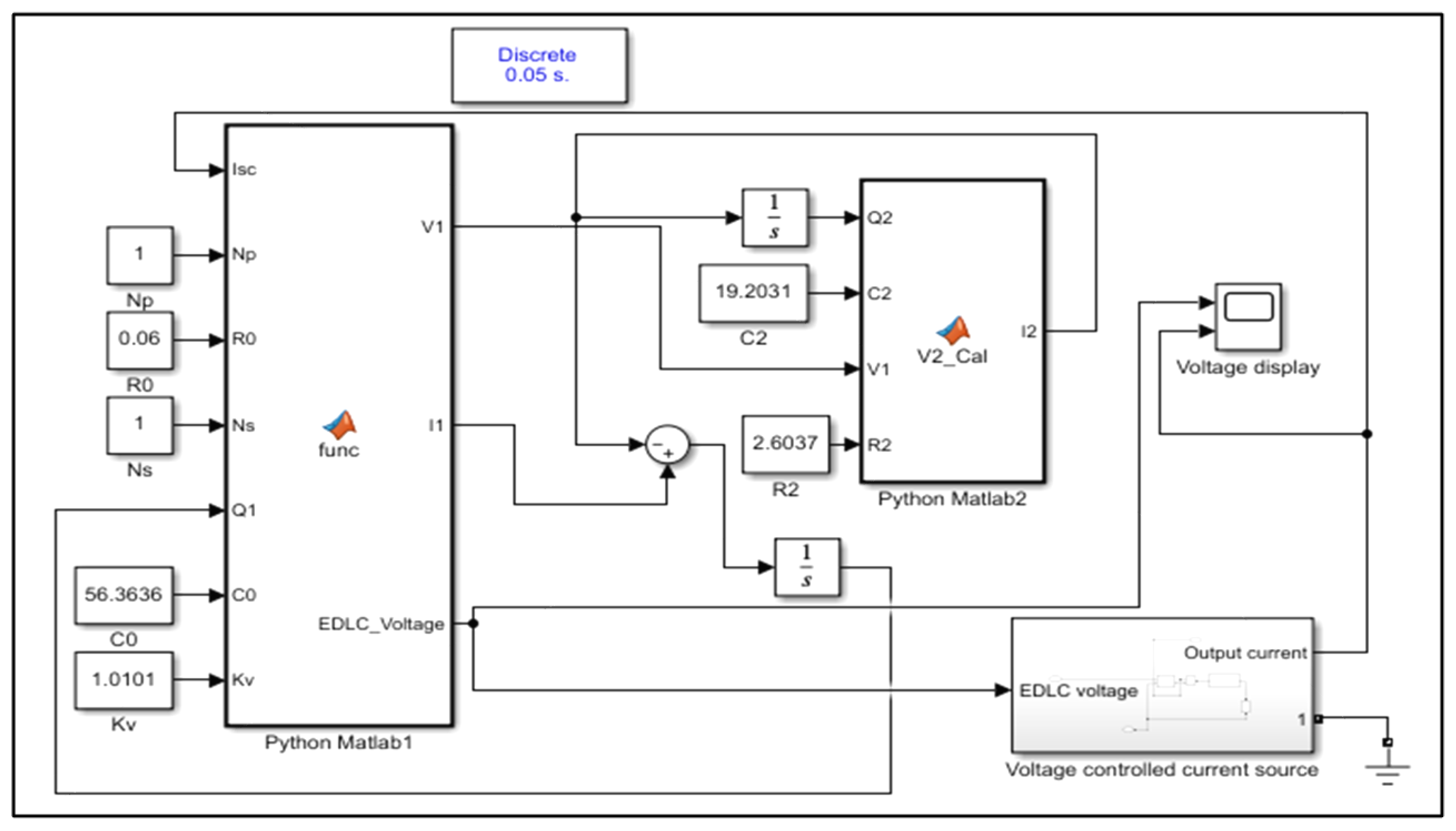
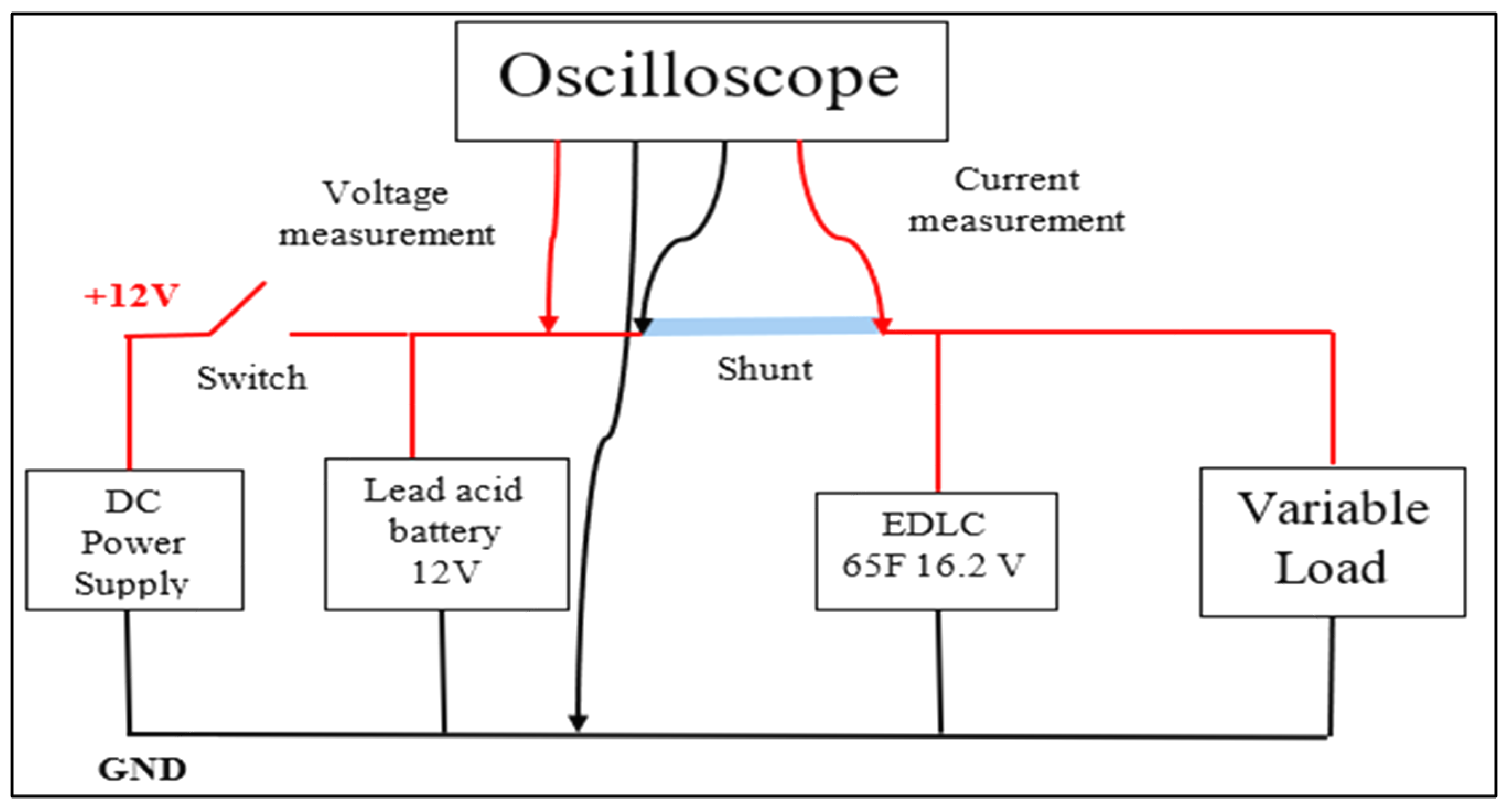
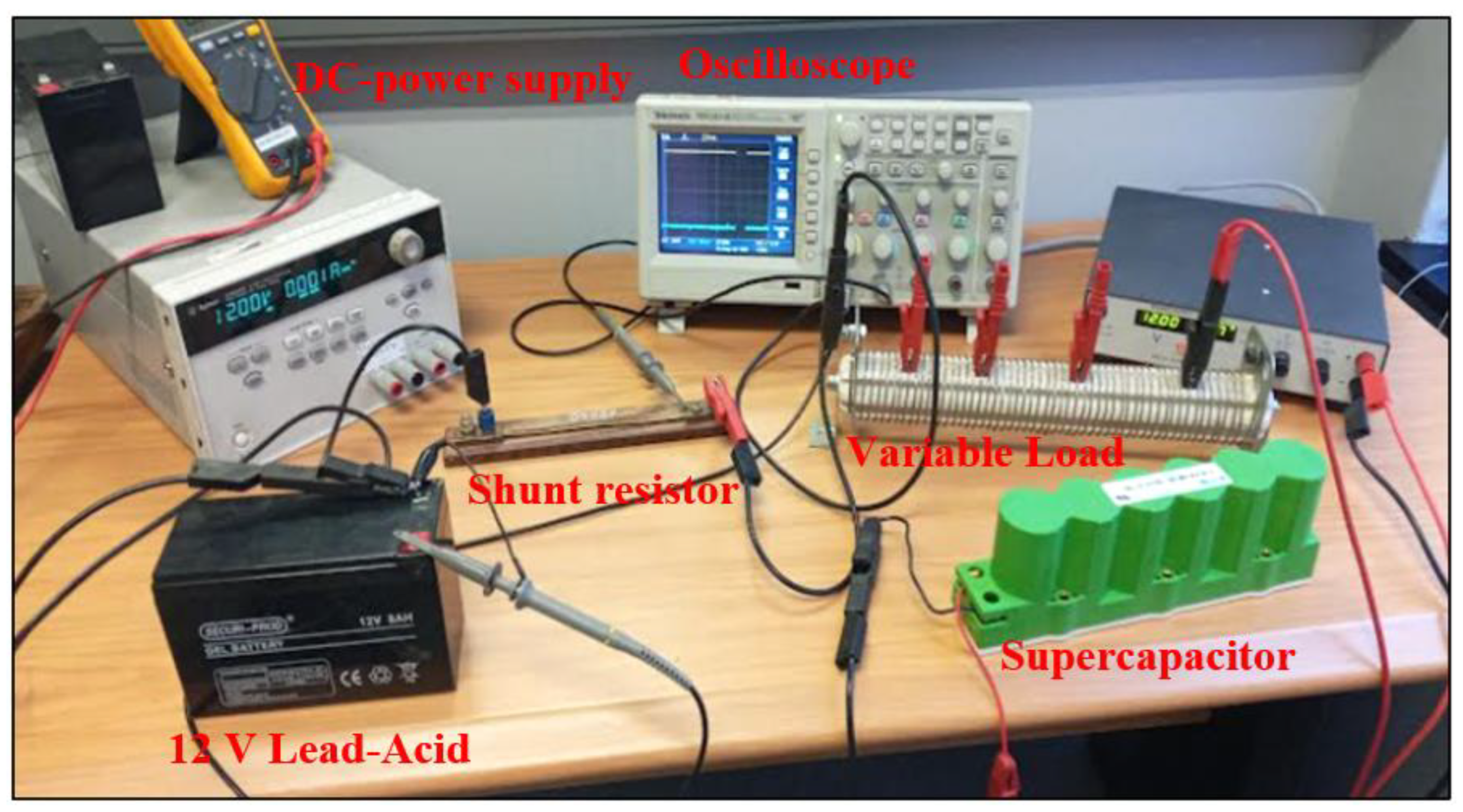
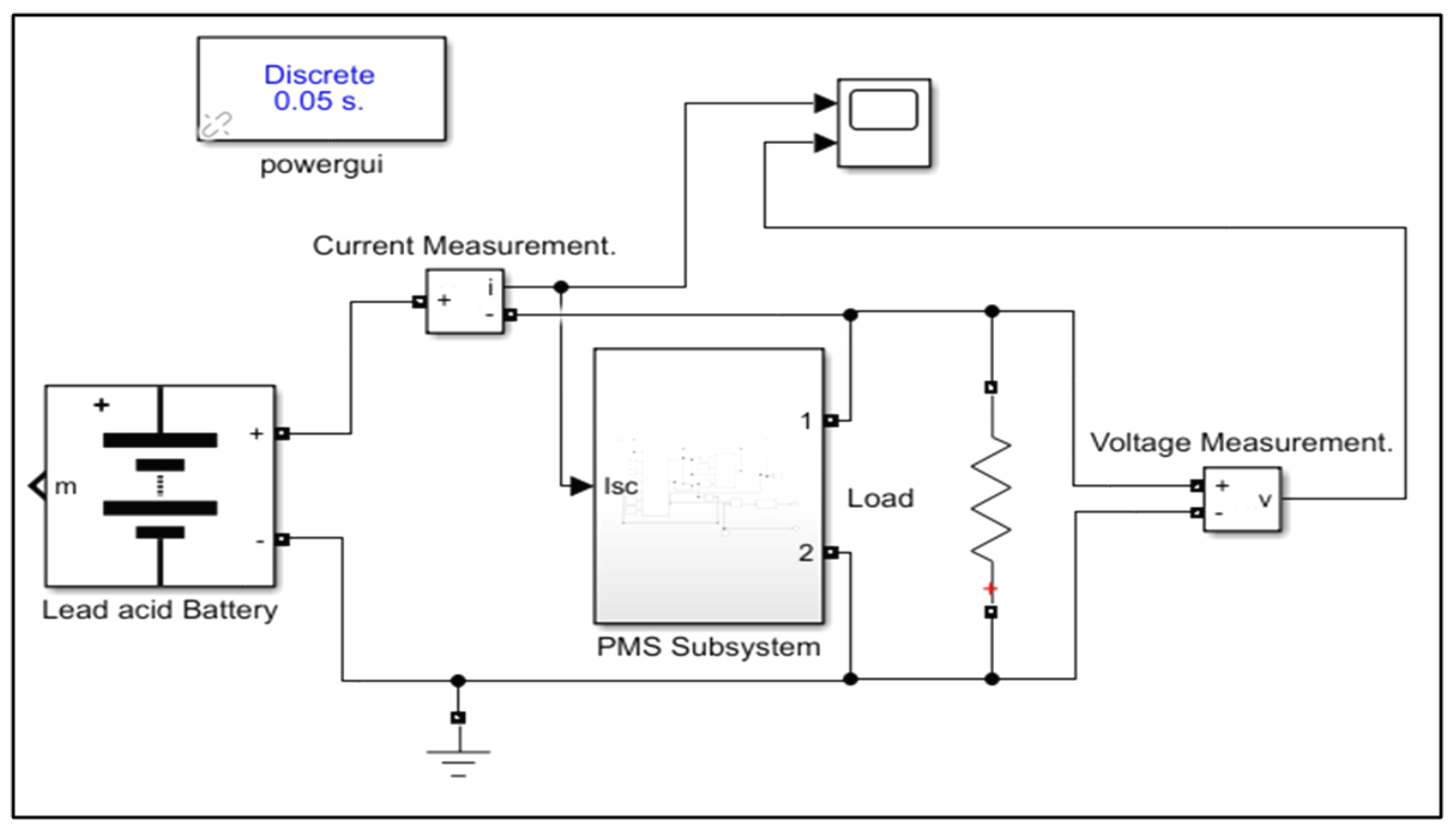
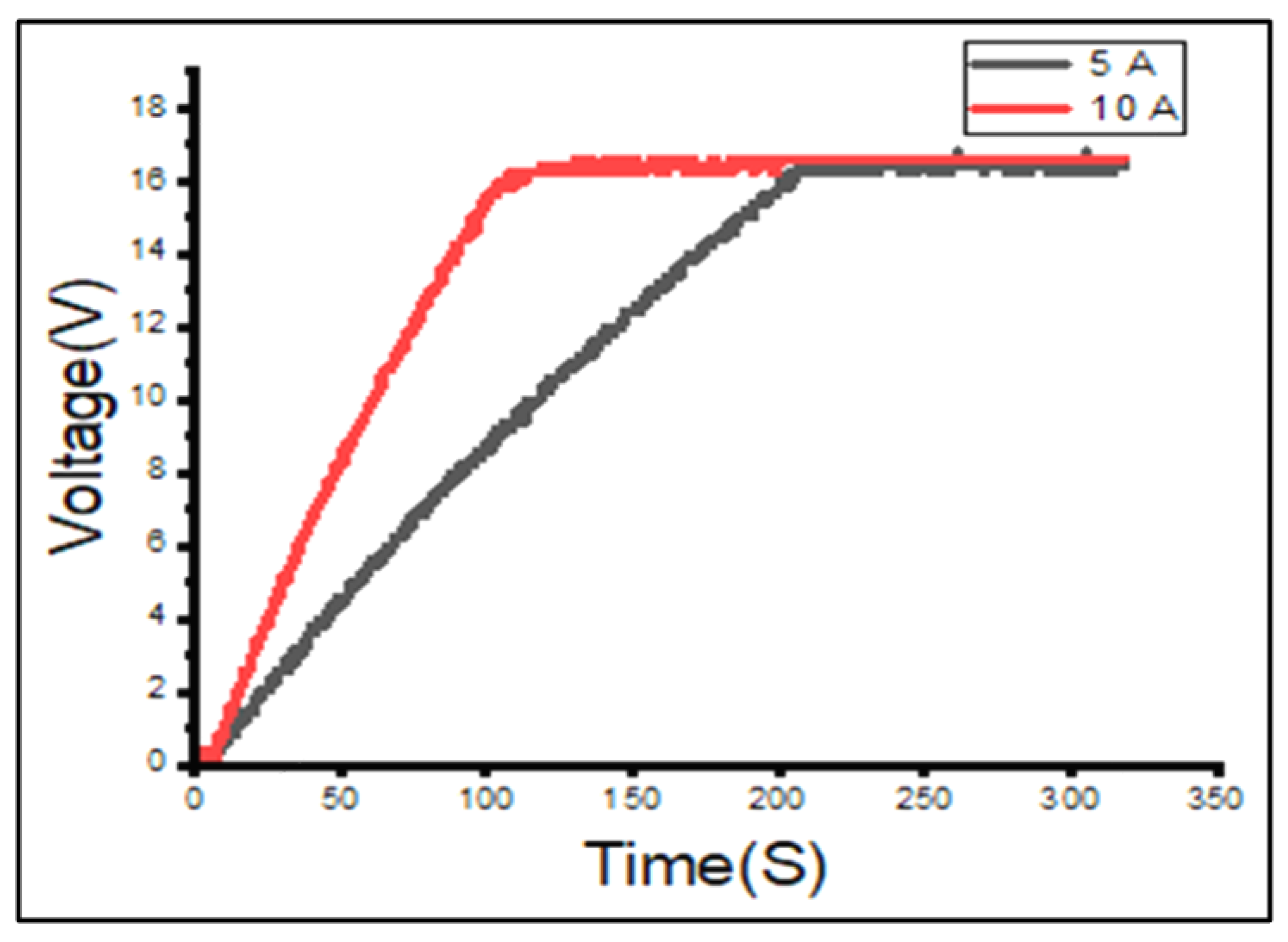

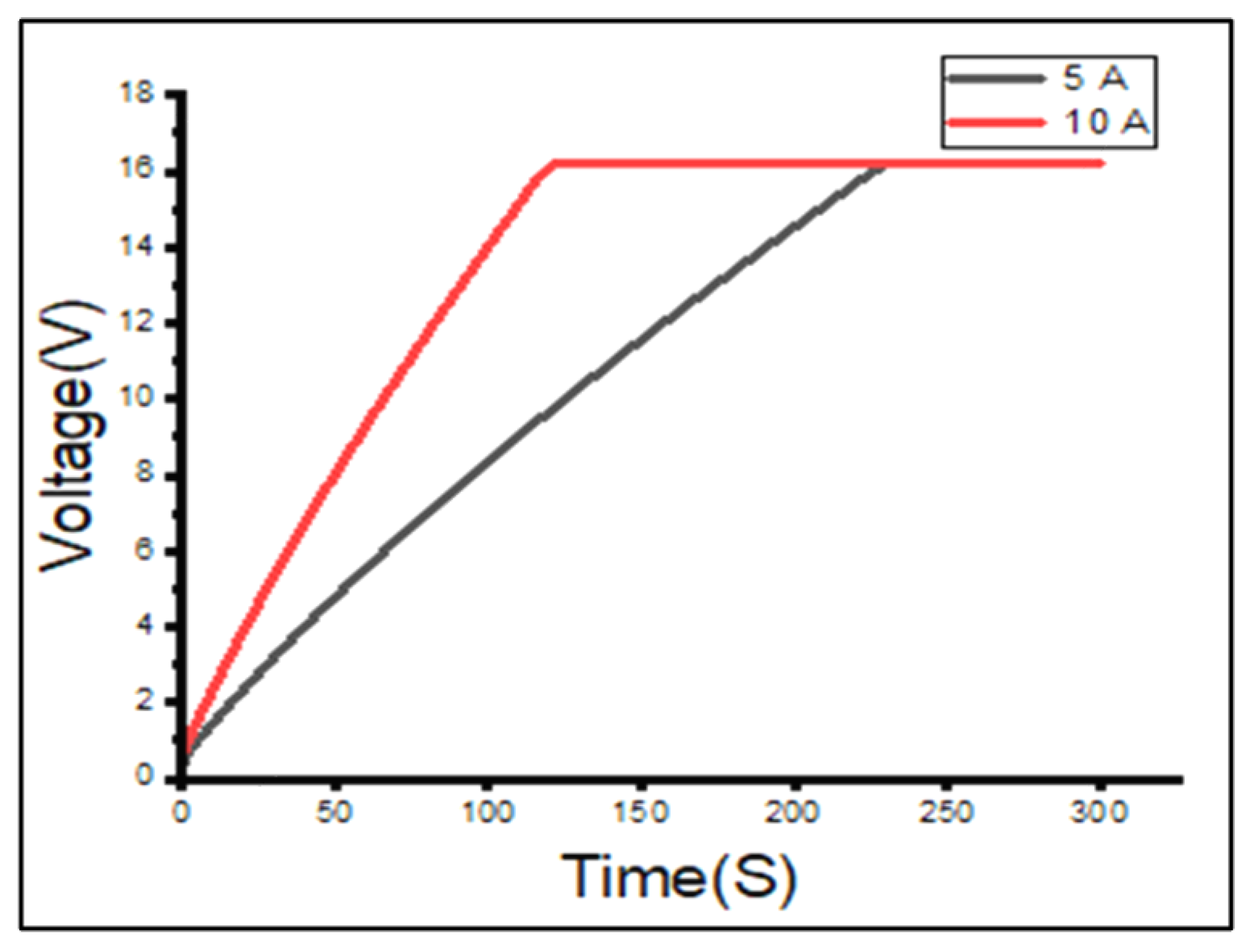

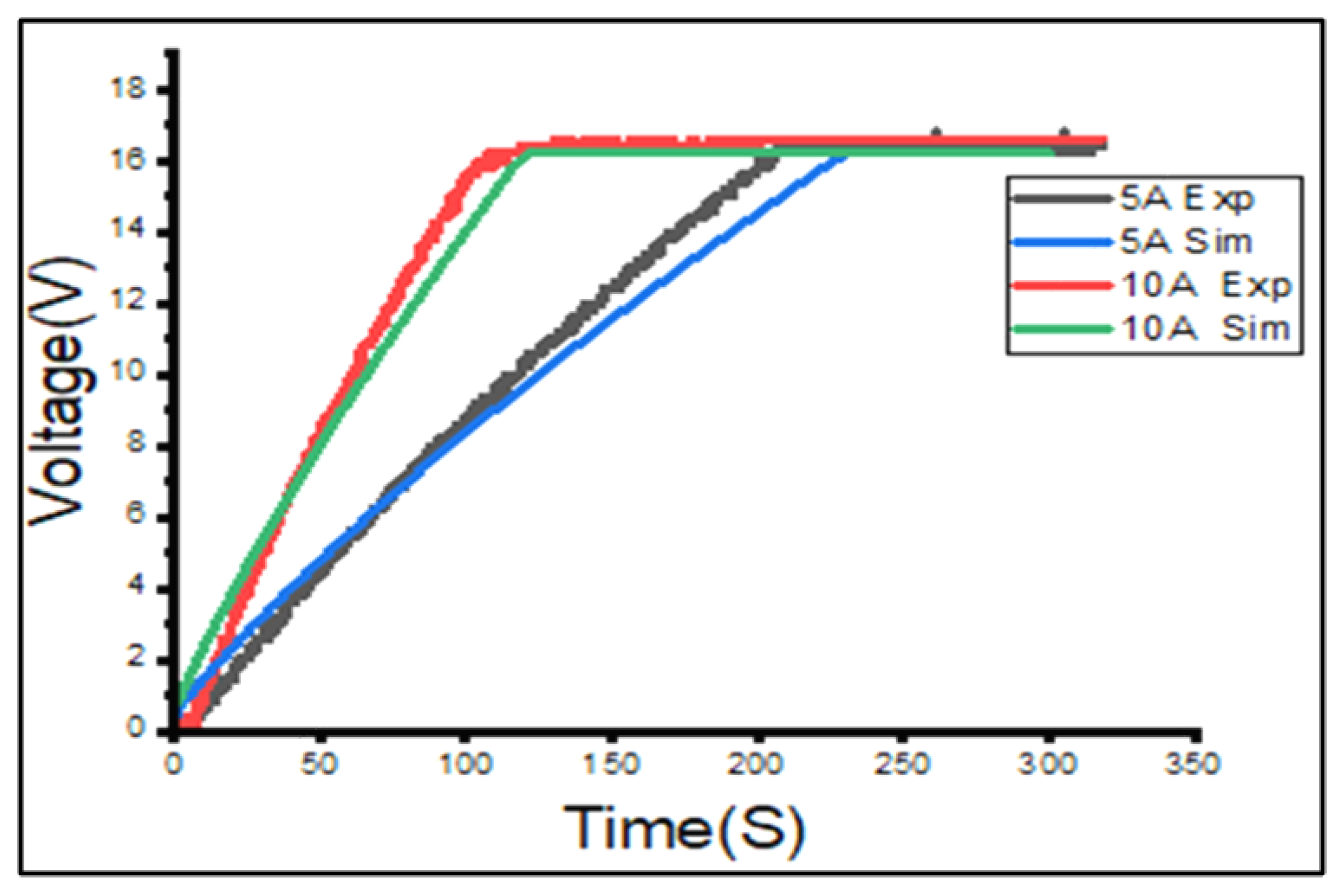
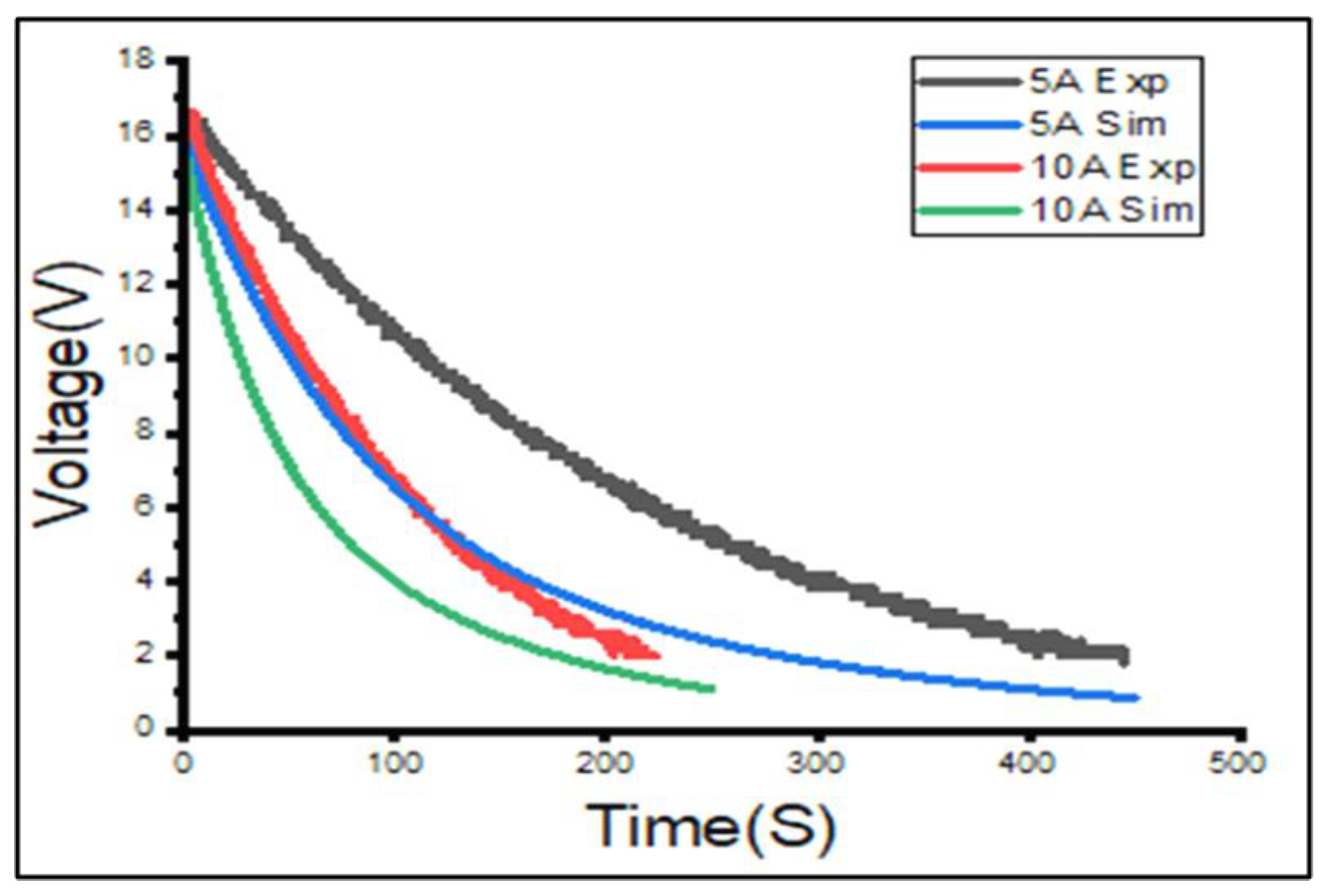
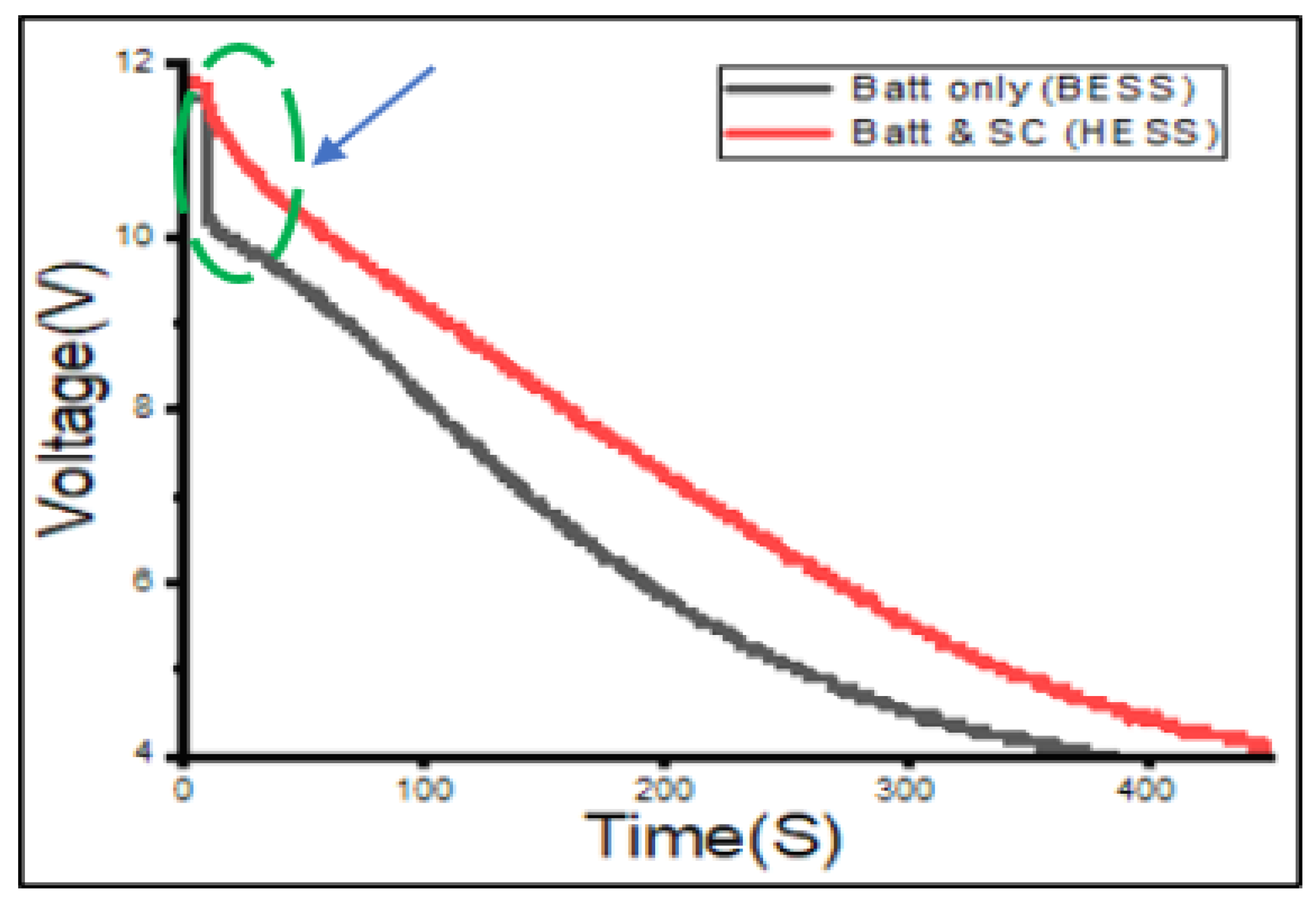
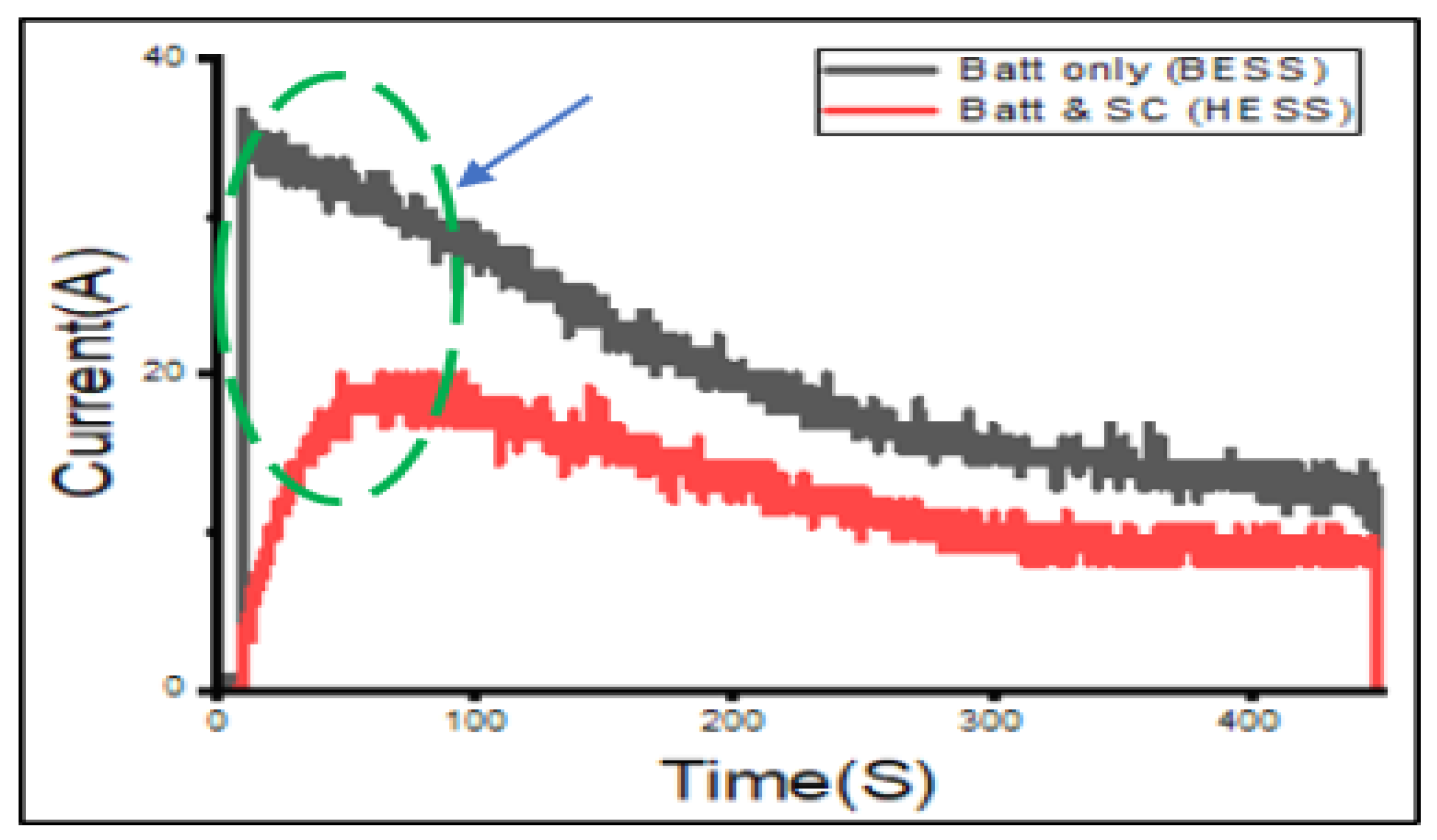
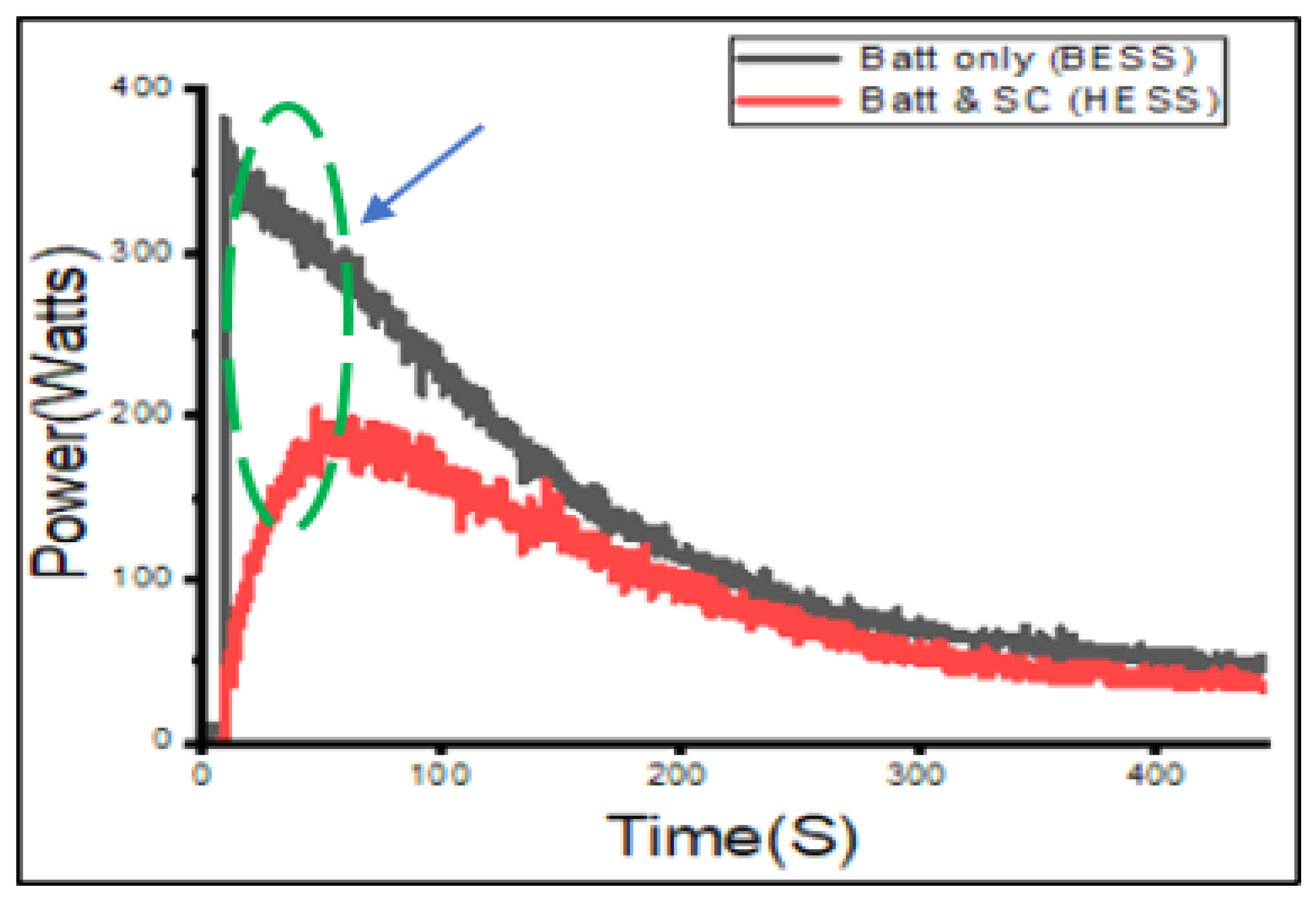
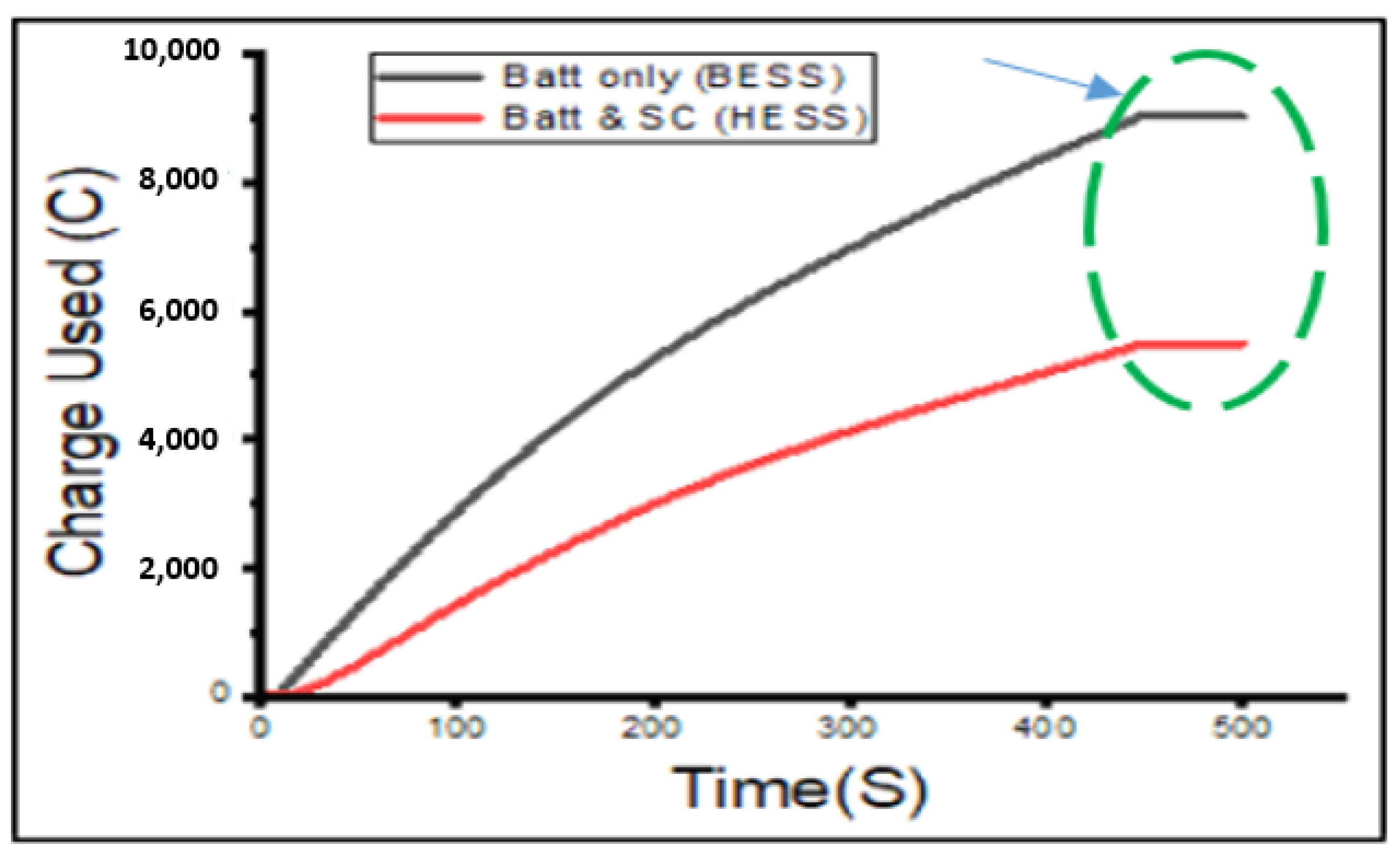


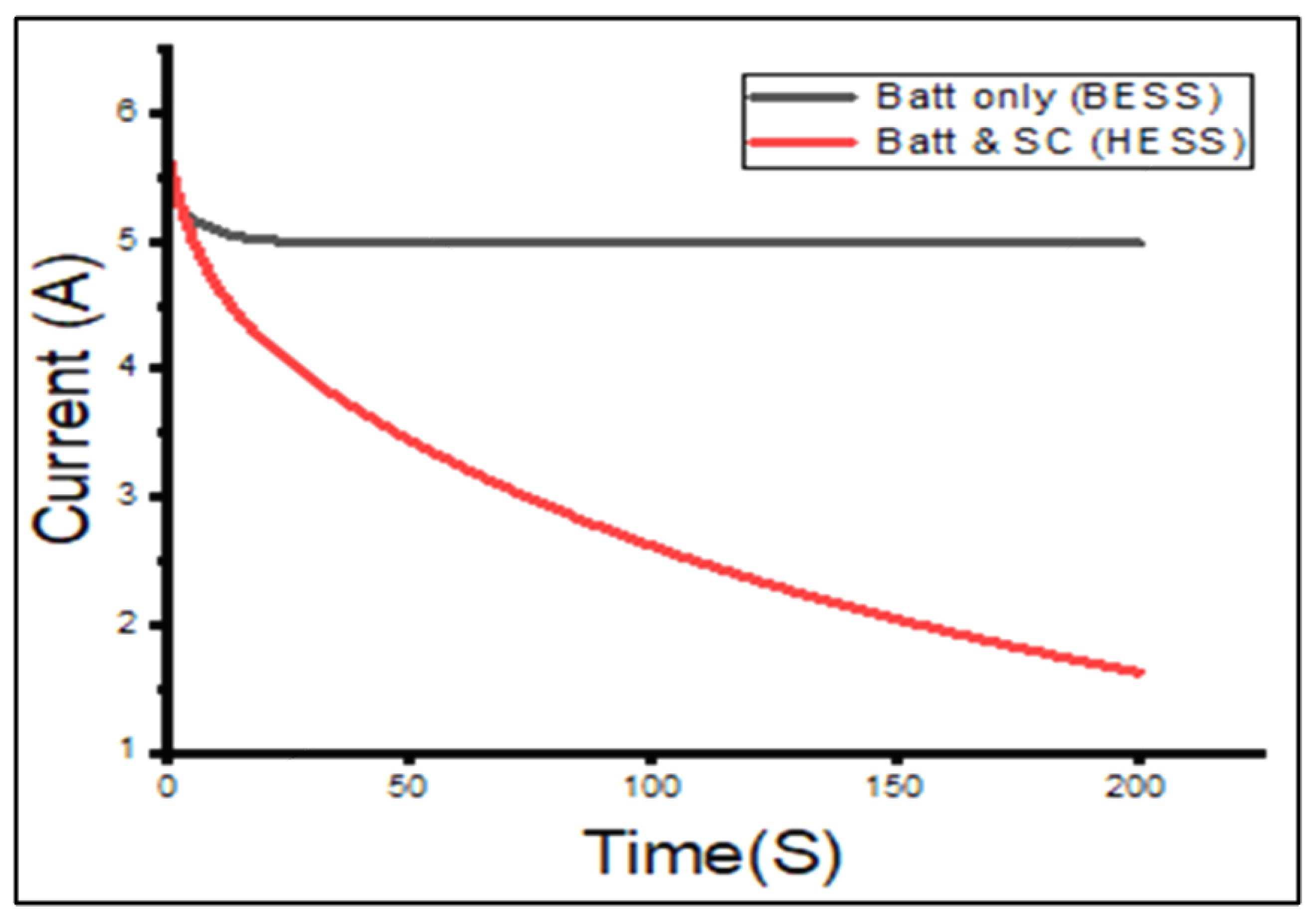
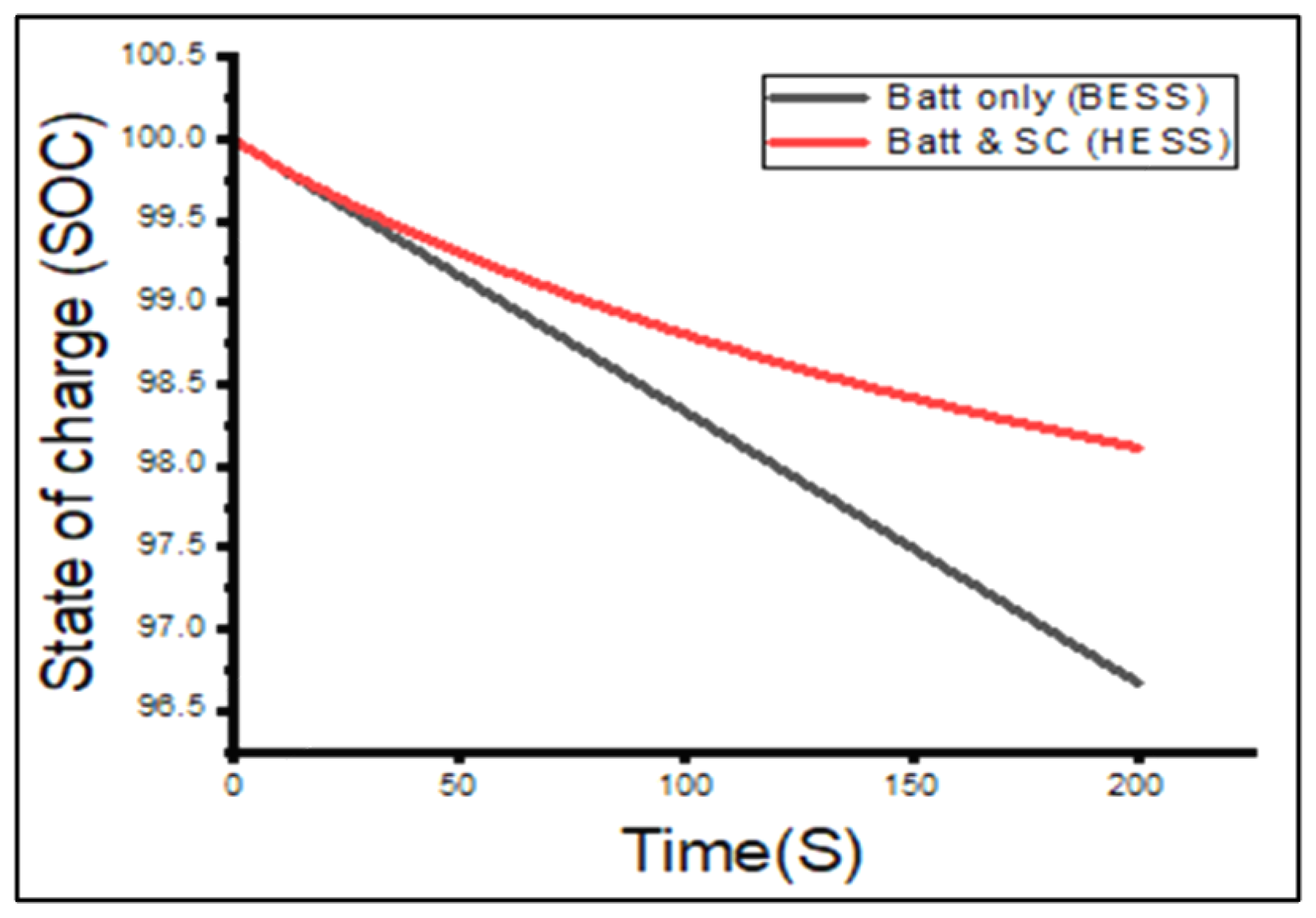
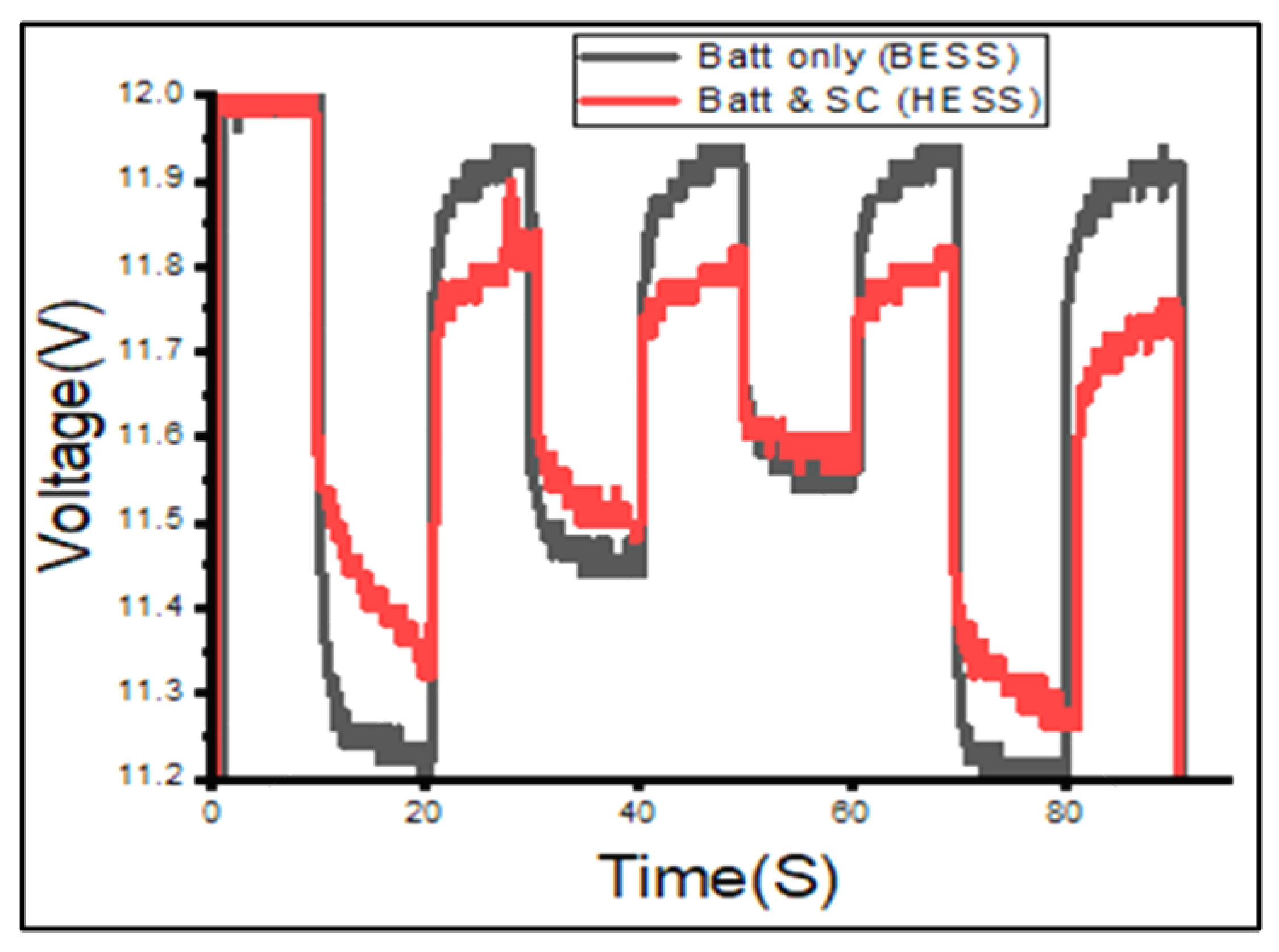
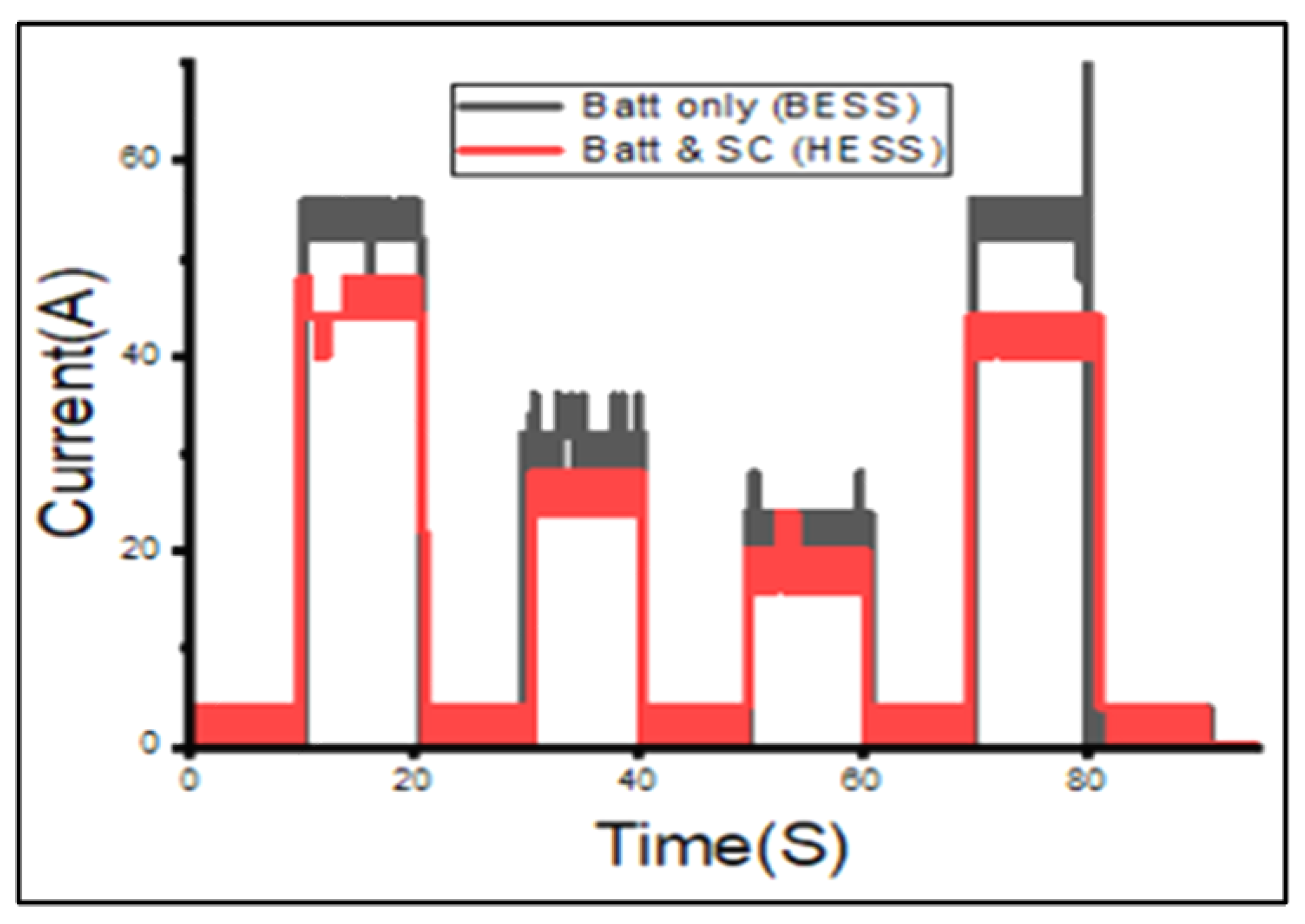
| Parameter | Value |
|---|---|
| Capacitance (F) | 65 |
| Voltage (V) | 16.2 |
| Parameter | Value |
|---|---|
| C0 (F) | 51.2362 |
| KV (F/V) | 1.3541 |
| C2 (F) | 16.7331 |
| R2 (Ω) | 5.9762 |
| R0 (Ω) | 0.06 |
| Parameter | Value |
|---|---|
| C0 (F) | 56.3636 |
| KV (F/V) | 1.0101 |
| C2 (F) | 19.2031 |
| R2 (Ω) | 2.6037 |
| R0 (Ω) | 0.06 |
| Parameter | Value |
|---|---|
| Rating (Ah) | 8 |
| Voltage (V) | 12 |
| Total charge (Coulombs) | 28,800 |
| Stress Factor | Reduction of Stress Factor | Reduction of Aging |
|---|---|---|
| Battery voltage values | Voltage drop reduced by 17% with EDLC | Reduces the degradation of active material lead dioxide ( |
| Current discharge value | Initial current spike reduced by 48.6% with EDLC | Reduces the formation of lead sulfate |
| Battery power value | Initial spike in power demand reduced by 48.6% with EDLC | Reduces the degradation of active material lead dioxide ( |
| Battery SOC percentile | 1.50% increase in SOC with an EDLC present within a duration of 5 min. | Reduces the formation of lead sulfate |
| Battery charge utilization | Charge used dropped by 44% with the EDLC | Reduces the degradation of active material lead dioxide ( |
Publisher’s Note: MDPI stays neutral with regard to jurisdictional claims in published maps and institutional affiliations. |
© 2022 by the authors. Licensee MDPI, Basel, Switzerland. This article is an open access article distributed under the terms and conditions of the Creative Commons Attribution (CC BY) license (https://creativecommons.org/licenses/by/4.0/).
Share and Cite
Tshiani, C.T.; Umenne, P. The Impact of the Electric Double-Layer Capacitor (EDLC) in Reducing Stress and Improving Battery Lifespan in a Hybrid Energy Storage System (HESS) System. Energies 2022, 15, 8680. https://doi.org/10.3390/en15228680
Tshiani CT, Umenne P. The Impact of the Electric Double-Layer Capacitor (EDLC) in Reducing Stress and Improving Battery Lifespan in a Hybrid Energy Storage System (HESS) System. Energies. 2022; 15(22):8680. https://doi.org/10.3390/en15228680
Chicago/Turabian StyleTshiani, Chrispin Tumba, and Patrice Umenne. 2022. "The Impact of the Electric Double-Layer Capacitor (EDLC) in Reducing Stress and Improving Battery Lifespan in a Hybrid Energy Storage System (HESS) System" Energies 15, no. 22: 8680. https://doi.org/10.3390/en15228680
APA StyleTshiani, C. T., & Umenne, P. (2022). The Impact of the Electric Double-Layer Capacitor (EDLC) in Reducing Stress and Improving Battery Lifespan in a Hybrid Energy Storage System (HESS) System. Energies, 15(22), 8680. https://doi.org/10.3390/en15228680







